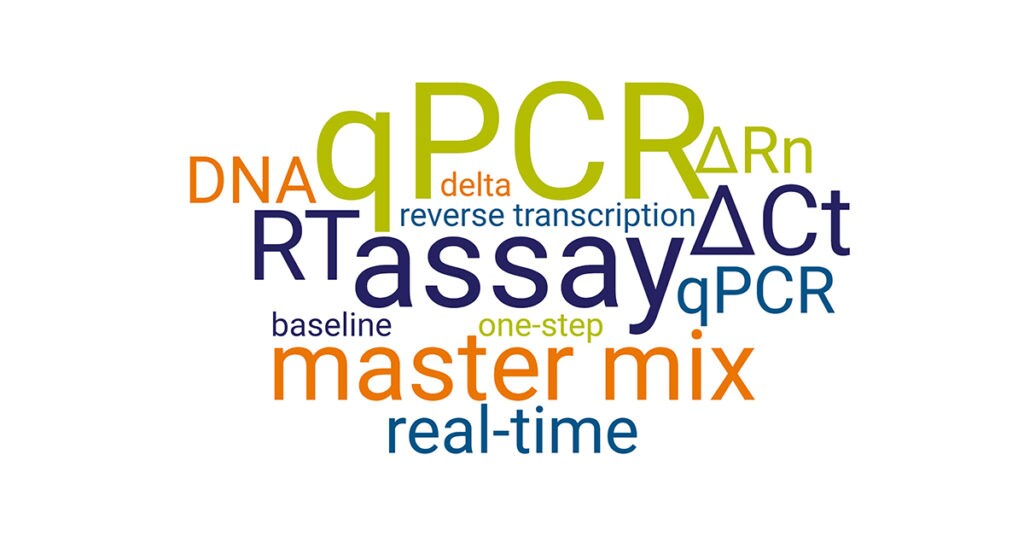
A Quick Guide to qPCR Terms and Acronyms
Understanding Real-Rime PCR Terminology
Be a qPCR Expert With Our Handy PCR Acronym Guide
qPCR has been a fundamental tool for molecular biology research for almost forty years and has become a standard technique in labs around the world. However, for many new and experienced researchers, keeping up with the evolving terminology and acronyms can sometimes be confusing.
Below you will find a quick reference guide with commonly used qPCR terminology and acronyms.
PCR: polymerase chain reaction—a common molecular biology technique that rapidly amplifies DNA target sequences to create millions of copies from a small amount of starting template.
qPCR: quantitative (or real-time) PCR—used for the sensitive, specific detection and quantification of nucleic acid targets. During PCR amplification, target amplicons are detected using fluorescent probes or dyes. The fluorescence signal is measured during each PCR cycle, enabling quantitation of the PCR target in real time.
RT: reverse transcription—the process by which complementary DNA (cDNA) is synthesized from an RNA template.
RT-qPCR: reverse transcription-qPCR—real-time PCR that uses RNA as the starting nucleic acid sequence template. The RNA is reverse transcribed into cDNA before PCR amplification.
cDNA: complementary DNA—DNA that is reverse transcribed from RNA; used as a template for PCR amplification.
One-step RT-qPCR—RT-qPCR that carries out reverse transcription and PCR amplification in the same tube.
Two-step RT-qPCR—RT-qPCR that carries out reverse transcription first, then a portion of the resulting cDNA is used as the template for PCR amplification.
qPCR baseline—low-level fluorescence emitted during early PCR cycles (noise).
Target threshold—signal intensity that reflects a statistically significant increase over the baseline; the threshold determines the quantification cycle (Cq).
Cq: quantification cycle—the PCR cycle in which the sample amplification curve crosses the target threshold; this is where the fluorescence signal exceeds background fluorescence, which indicates true amplification. Cq has also been referred to as threshold cycle (Ct), crossing point (Cp), and take-off point (TOP), all meaning the same thing. MIQE guidelines [1] prefer quantification cycle (Cq).
Δ (delta)—difference between two values.
ΔCt– difference between the Ct values of your target gene and your endogenous control.
ΔΔCt— the difference between the normalized dCt of a test sample and the dCt of the reference sample.
Rn: normalized reporter— the fluorescence emission intensity of the reporter dye divided by the fluorescence emission intensity of the passive reference dye.
ΔRn—Rn value of an experimental reaction minus the Rn value of the baseline signal.
SNP (pronounced snip): single-nucleotide polymorphism—a simple form of genetic variation that can influence an individual’s susceptibility to disease or response to drugs or be used to trace the inheritance of specific genes and traits of interest.
PCR assay—combination of target-specific primers and one or more probes optimized for specific applications, including gene expression, SNP genotyping, miRNA analysis, mutation detection, and copy number variation analysis.
Master mix—a mixture of polymerase, salts, magnesium, dNTPs, and optimized reaction buffer; master mix choice depends on the qPCR application.
MIQE guidelines, or MIQE: minimum information for publication of quantitative real-time PCR experiments—targets the reliability of results to help ensure the integrity of the scientific literature, promote consistency between laboratories, and increase experimental transparency; encourages better experimental practice, allowing more reliable and unequivocal interpretation of qPCR results [1].
Many of these terms are covered in the Applied Biosystems™ Taq Talk™ video series in episode 1, “Understanding Real-Time PCR Terminology” – available now. If you’re in search of more qPCR education, please visit our qPCR learning center, where you’ll find a plethora of resources covering everything from real-time PCR basics to miRNA analysis.
Related: Real-Time PCR (qPCR) Basics
Reference
- Bustin SA, Benes V, Garson JA, et al. The MIQE guidelines: minimum information for publication of quantitative real-time PCR experiments. Clin Chem. 2009 55(4):611-22. doi: 10.1373/clinchem.2008.112797.